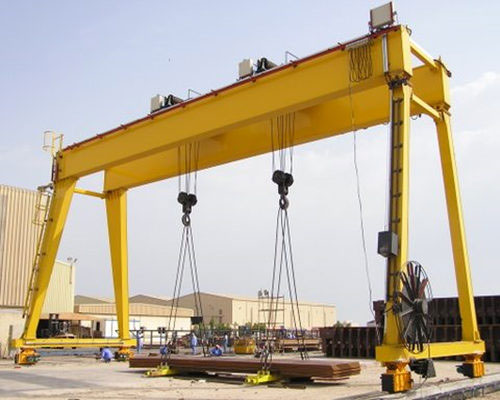Safety operating procedures for cranes
Cranes are used to lift heavy objects, so operational safety is very important. If there are problems during operation, the consequences are unimaginable, so safety must be taken into account when operating the crane.

1、 The crane should be operated by a full-time driver who has received specialized training and obtained a special operation certificate, and has passed the assessment of the safety and environmental management department and obtained a work permit. The crane driver should operate the lifting machinery corresponding to the operation certificate.
2、 Crane drivers should strictly follow the maintenance plan formulated by the construction site for daily maintenance work. The inspection, maintenance, work content, and handover situation before and after each shift should be truthfully recorded in the construction machinery operation and maintenance records.
3、 Newly installed, overhauled, or significantly modified lifting machinery must undergo load testing in accordance with the relevant regulations for crane performance testing before use. After passing the test and obtaining relevant procedures and safety permits, it can be put into use.
4、 Crane drivers must strictly follow the provisions of the "Crane Safety Supervision and Management System" for daily inspections before and after work, and can only start working after confirming that the crane has no faults or hidden dangers.
5、 Crane drivers and crane commanders should communicate according to various prescribed gestures or signals. During the operation, the driver should closely cooperate with the lifting command and obey the command signals. But in case of danger during lifting operations, regardless of who issues the emergency stop signal, the driver should immediately stop the vehicle.
6、 After receiving the lifting signal from the commander, the driver must first sound the signal before taking action. When lifting heavy objects, it is necessary to first lift them off the ground. After confirming that the heavy object is securely hung, the braking performance is good, and the crane is stable, continue lifting.
7、 When lifting heavy objects, the wire rope of the hook should be kept vertical, and it is forbidden for the wire rope of the hook to drag the lifted object in an inclined state. When the hook has been hung but the lifted object has not yet been lifted, it is forbidden for the crane to move its position or make rotational movements.
8、 When lifting and rotating heavy objects, the speed should be uniform and steady to avoid danger caused by the swinging of heavy objects in the air. When lowering heavy objects, do not go too fast to prevent them from suddenly falling and causing damage. When lifting long or large heavy objects, a dedicated person should pull the rope to prevent accidents caused by the swinging of the object.
9、 When the crane is working, personnel unrelated to the lifting operation are strictly prohibited from staying on the crane.
10、 Crane drivers should adhere to the "Ten No Lifting" principle during operation:
1. Not lifting beyond the rated load of the lifting machinery;
2. Insufficient lighting, unclear command signals, or failure to hang under the command of non commanding personnel;
3. The sling and accessories are not securely tied and do not meet safety requirements for lifting.
4. The crane suspends heavy objects directly for processing without lifting them;
5. Slanting and pulling without lifting;
6. Flammable and explosive dangerous goods, no safety work permit, no lifting without safety measures;
7. Do not lift when there are people standing on the workpiece or moving objects floating on the workpiece;
8. Failure to take measures to prevent steel wire rope wear on edges and cutting edges without lifting;
9. Objects buried underground or of unknown weight are not suspended;
10. Do not lift during field work when encountering heavy snow, thunderstorms, or winds above level six.
11、 When operating a crane, the operator should comply with the following technical requirements:
1. Do not use the limit position limiter to park;
2. Do not adjust the brake of the lifting and slewing mechanism under load;
3. When lifting, it is not allowed to pass over people and there should be no people under the crane arm;
4. Inspection and maintenance are not allowed during the operation of the crane;
5. When the lifted object approaches or reaches the rated lifting capacity, the brake should be checked before lifting, and a small height and short stroke test should be used before lifting it smoothly;
6. For cranes without limit position limiters for descent, when the hook is in the lowest working position, the steel wire rope on the drum must maintain a safe number of turns as specified in the design;
7. When the crane is working, the minimum distance between the boom, lifting equipment, accessories, steel wire rope, cable wind rope, and heavy objects and the power transmission line should not be less than the provisions in the table below.
Minimum distance from transmission line
Transmission line voltage V (kV)<1 1 1-35 ≥ 60
Minimum distance (m) 1.5 3 0.01 (V-50)+3
8. Mobile cranes should level the parking area according to the instructions before operation, and securely and reliably set up the support legs;
9. For cranes without reverse braking performance, except in special emergency situations, reverse brakes shall not be used for braking.
12、 During construction, in case of the following situations, a safety work permit must be obtained first, safety technical measures must be formulated, and the construction technical leader must be present to command:
1. The lifting weight reaches 90% or more of the rated load of the lifting machinery;
2. Lifting precision objects or large items that are difficult to lift, or lifting large items in complex places;
3. Lifting machinery working under or near power transmission lines;
4. Two or more cranes lifting the same object;
5. When explosives and dangerous goods must be lifted.
13、 When two or more cranes lift the same object:
1. When tying, the load should be distributed proportionally based on the allowable lifting capacity of each crane;
2. During the lifting process, the wire ropes of the hooks of each crane should be kept vertical, and the lifting and walking should be synchronized; The load borne by each crane shall not exceed 80% of its rated capacity.
14、 A crane with two sets of lifting mechanisms, the main and auxiliary hooks, must not be operated simultaneously. Except for specialized cranes that are allowed to be used simultaneously in the design, and comply with the provisions of Article 13.
15、 Cranes are strictly prohibited from operating three actions simultaneously, and two actions must not be operated simultaneously when approaching the rated load. It is strictly prohibited to lower the boom of a boom crane when approaching the rated load.
16、 Without the consent of the company's mechanical management department, all mechanisms and devices of the lifting machinery shall not be changed or replaced.




